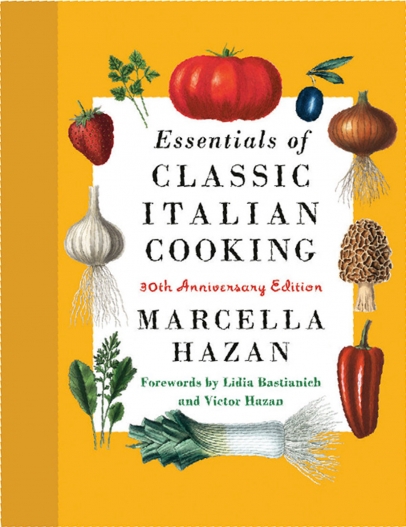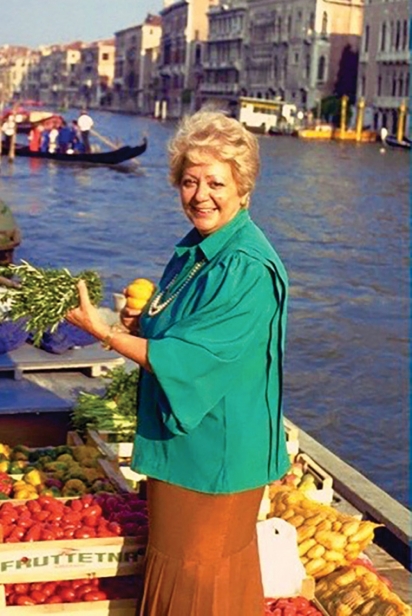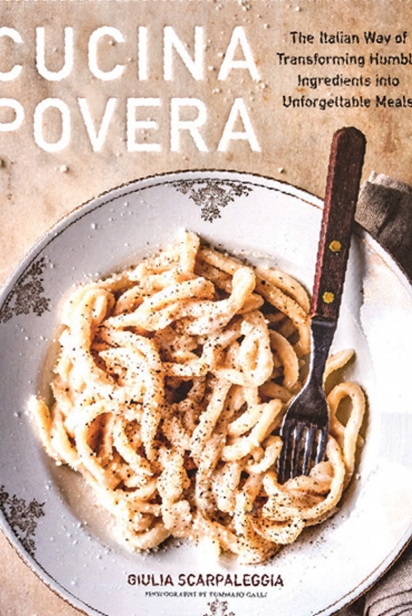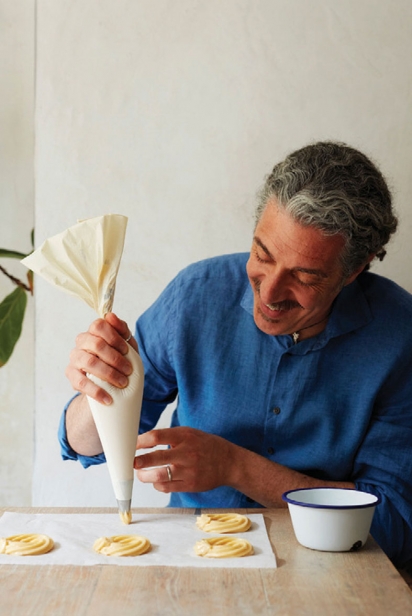Chapter and Verse on Italian Cooking
Chapter and Verse on Italian Cooking
Essentials of Classic Italian Cooking 30thAnniversary Edition
BY MARCELLA HAZAN
(Borzoi Book/Alfred A. Knopf, 2022)
JUST AS THE BELOVED original more than 30 years ago, Marcella Hazan’s anniversary edition of Essentials of Classic Italian Cooking provides a thread to how and what Italians—in Italy—eat.
“She respected the seasonality and the simplicity of Italian food,” writes Lydia Bastianich, fellow chef and author, in the foreword. “Her recipes are simple, delicious, and authentic, but most important, they work.”
Dubbed “The queen of Italian cooking” by the Chicago Tribune for introducing Americans to authentic Italian food, Hazan, who died in 2013, instills concise geography and history lessons as much as recipes.
Born in Northern Italy’s EmiliaRomagna region, Hazan was a math and science teacher before relocating to America as a newlywed in 1955. “She had never cooked, and knew nothing about cooking,” recounts her husband, Victor, in the foreword. He shared with her an old Italian cookbook he had brought back. “Marcella looked through it, but she mostly looked into herself.”
Like its original, this cookbook includes updated recipes from Hazan’s first two books —The Classic Italian Cook Book and More Classic Italian Cooking— acknowledging the greater availability of certain ingredients. “Perhaps without my always being conscious of it, the dishes continued to evolve, moving always toward a simpler, clearer expression of their primary flavors, and toward a steadily diminishing dependence on cooking fat,” she writes.
The book starts with “Fundamentals: Where Flavor Starts,” a 50-plus-page foundation that Hazan aptly calls “a mini-encyclopedia of Italian food,” that “is densely packed with information about cooking techniques and the herbs and cheese used in an Italian kitchen,” as well as recipes for bases, and “how to choose and use such ingredients as balsamic vinegar, bottarga, extra virgin olive oil, porcini mushrooms, radicchio, truffles, dried pasta, different varieties of rice, and so on.”
Equally valuable, “Understanding Italian Cooking” follows with how, like dialects, each area of Italy has flavors all its own—“regions that until 1861 were part of sovereign and usually hostile states, sharing few cultural traditions”— and are differentiated by the small country’s wide range of climatic zones. Where plants thrive, certain sauces shine. Where wheat reigns, so does pasta. With such an abundance of shorelines, expect fish dishes.
Still, Italy’s greatest cooking is everywhere, she writes. “It is not the created, not to speak of ‘creative’ cooking of restaurant chefs. It is the cooking that spans remembered history, that has evolved during the whole course of transmitted skills and institutions in homes….”
“All roads lead to the home, to la cucina di casa—the only one that deserves to be called Italian cooking.”
Almost 100 pages of the more-than-700-page tome focuses on “The Essentials of Cooking Pasta,” from salting the pot to pasta sauces and which sauces belong with which pastas. Hazan also dedicates entire chapters to risotto, polenta and frittate, before reaching chapters covering fish and shellfish, veal, beef and lamb.
Hazan rounds out the book with vegetables and, like a proper Italian meal, the often-light salad course which “signals the approaching end of the meal. It releases the palate from the grip of the cook’s fabrications, leading it to cool, fresh sensations, to a rediscovery of food in its least labored state.”
Don’t worry: Desserts are aplenty, with recipes for Italian praline, puddings, fritters and more, including Diplomatico, a chocolate dessert where layers of rum- and coffee-soaked cake alternate with a mousse-like and chocolate filling about which Hazen wonders if any other dessert “rewards such little effort with such gratifying results.”
As the perfect bookend to Hazan’s “Fundamentals,” “At the Table: The Italian Art of Eating” brings readers back to the beautiful foundation that is essential to Italian eating and how with few exceptions, Italian meals have no “main,” because “a single dominant course goes against eating in the Italian way, which consists of working one’s way through an interesting and balanced succession of small courses.”
Hazan even supplies menu examples for rustic meals, a fish feast and holidays, among others. After all, the teacher who so thoroughly researched her culinary heritage to better understand cooking knew to make such exploration easier for others, particularly Americans. She more than succeeded in doing just that.
Cucina Povera: The Italian Way of Transforming Humble Ingredients into Unforgettable Meals
BY GIULIA SCARPALEGGIA
(Artisan, 2023)
GIULIA SCARPALEGGIA calls cucina povera—a cooking style of Italian peasants and nomads—“the highest expression of the Italian arte dell’arrangiarsi, the art of making do with what you’ve got.”
It’s “the use of humble ingredients, seasonal vegetables, and simple cooking techniques, along with a healthy dose of imagination. This culinary approach may be ancient, but it is still relevant today; it is a way of cooking that transforms simple ingredients into hearty meals that are more than the sum of their parts,” she writes.
So begins Cucina Povera: The Italian Way of Transforming Humble Ingredients into Unforgettable Meals, where many ingredients are, or at least probably should be, within reach—both physically and financially—to reinvent leftovers like day-old rice, bread, cheeses and meats.
“The ingredients may be simple, but when you use them the Italian way, you will never feel like you are missing out,” she writes, sharing examples that require only a few ingredients. “Think of cacio e pepe or polenta.”
Scarpaleggia recalls how her grandmother stored leftover pieces of stale bread to soon become “stuffing for green peppers, a topping for roasted vegetables, or, in summer, panzanella.”
“The most important principle of Italian cucina povera is an economical, waste-not approach, which is still practiced today in most Italian households.”
The methods are among the most approachable in a kitchen: slow-cooked stews and comforting casseroles, with recipes like involtini di peperoni alla piemontese (roasted pepper rolls stuffed with tuna and capers), risi e bisi (rice and pea soup) and risotto alla zucca (roasted squash risotto).
Throughout, Scarpaleggia includes information such as “The Culture of Rice in Italy,” with details about the regions and tasting notes of popular varieties, “Italian Street Food” and “The Ingredients that Make a Traditional Ribollita” and what to make with leftover polenta, among others.
Meat dishes focus on “the nose-to-tail approach to cooking,” with recipes that incorporate offal, or innards, as well as less popular and less expensive cuts of meat, along with dishes that bring it all together like Florentine beef stew, a savory Swiss chard and ParmigianoReggiano pie. Other chapters focus on poultry and rabbit, fish and seafood, milk and cheese, beans and lentils and potatoes, corn and chestnuts, and desserts, before finishing with suggestions for making stocks and preserving tomatoes.
“Long before the farm-to-table movement became trendy on restaurant menus, it was the only way Italian peasants and farmers ate. Seasonal vegetables have always had a central role in cucina povera.”
Giuseppe’s Italian Bakes: Over 60 Classic Cakes, Desserts and Savoury Bakes
BY GIUSEPPE DELL’ANNO
(Quadrille, 2022)
WHEN GIUSEPPE Dell’Anno set out to write a cookbook filled with “timeless Italian classics,” he soon found the topic to be far too vast for one book. So he decided to pare it down to the recipes that meant the most to him.
“The result is a collection of simple and effective home bakes, deliberately designed to be accessible to the most inexperienced baker as well as to those who have already been baking a while,” writes the winner of “The Great British Bake Off ” and “The Great British Baking Show.”
That included his dad’s recipes, which Dell’Anno describes as being more a scribble of ingredients. Ultimately, he understood.
“Only as an adult, I realized that I had unknowingly learned much more from my dad than I ever imagined and, most importantly, that through his silences and cryptic answers he had actually passed on all of his relentless passion for baking and cooking.”
Like in Marcella Hazan’s Essentials of Classic Italian Cooking, Dell’Anno touches upon the regional differences in Italian food. “Foreigners refer to Italian cuisine as if there was only one, recognized across the country and acknowledged as such. The reality is that there are many Italian cuisines: one per region, one per city, one per family even. Italy as we know it today, is only just over 160 years old; in fact, some of the recipes in this book are older….”
As an example, Dell’Anno suggests that asking 10 Sienese for a ricciarelli recipe would get you 10 different recipes because “each nonna or nonno baking those biscuits in their kitchen will have perfected the recipe to their own taste and will be ready to swear that their recipe is better.”
The book includes a glossary of sorts, detailing ingredients and equipment before diving into a chapter on cakes and tarts, with recipes of lesser-known cakes like torta sette vasetti alla mele (seven-pot cake with apples) and torta tenerina (little tender cake), along with more common desserts like tiramisù. He also has recipes for cookies—including Sienna’s ricciarelli—and cannoncini (puff pastry cannoli).
Giuseppe also bakes savory, with recipes for rotoli di pizza ai peperoni (pizza rolls with sweet peppers), focaccia genovese, same-day pizza margherita, calzoni and others.
“My guiding principle throughout my research was to respect those recipes and avoid the temptation of adjusting them to what a foreign audience would consider palatable today. But that does not mean that you should too: do not be afraid of experimenting. Play with these recipes—change the shapes, rearrange the combinations, adjust the flavours to your own taste.”
Doing so, he writes, will make them authentic to you.
Cara Catallo is editor of edibleWOW and author of Pewabic Pottery: A History Handcrafted in Detroit and Images of America: Clarkston.








